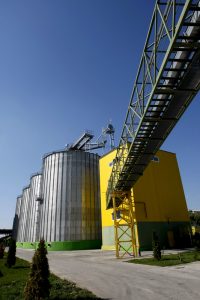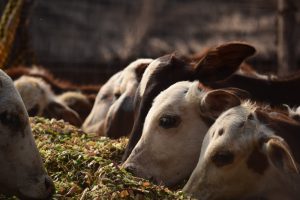It is classified as a concentrated and energy-rich feed ingredient. Its water content varies but never exceeds 27% (Table 1).[register]
 16 Jun 2023
16 Jun 2023
Glycerol, also known as glycerin, can be obtained through biodiesel production from vegetable oils or animal fats.
Through a process called “transesterification,” the fatty acids are separated from glycerol and re-esterified into an alcohol known as methanol, leaving glycerol as a residue.
For every 100 kg of biodiesel produced, approximately 4 to 10kg of glycerol is obtained.
With the growth of the biodiesel industry, the use of glycerol in livestock diets is gaining increasing interest due to its greater availability and more favorable prices.

This by-product is a viscous liquid that needs to be stored at temperatures above 13°C to ensure fluidity.
According to the FAO, glycerol is recognized as a safe ingredient for animal diets. However, the levels of methanol found in this by-product obtained from biodiesel production must be taken into account.
Its purity depends on the processes to which it is subjected to. The higher the purity, the lower the methanol content it contains.
This is why variable levels of methanol can be found, ranging from 1.3% to 27%. The latter is an undesirable alcohol for livestock feed due to its toxicity.
In ruminants, methanol toxicity is lower than in monogastric animals, thanks to ruminal bacteria that can detoxify this alcohol. However, under the presence of high doses or in unaccustomed animals, renal and nervous disorders may occur.

Glycerol as a nutrient
It is classified as a concentrated and energy-rich feed ingredient. Its water content varies but never exceeds 27% (Table 1).[register]
This offers advantages over other ingredients with higher water content in terms of transportation and storage.
Both glycerol and corn have similar energy values. However, for diets with a high starch content (55% of dry matter), the energy value of glycerol as a replacement for corn decreases.
This could be due to the fact that the inclusion of glycerol in ruminant diets may reduce fiber digestibility. However, studies are still inconclusive in this regard.
Table 1. Chemical composition (on a dry matter basis) of glycerol based on its purity

Ruminal metabolism
Glycerol is completely degraded by ruminal fermentation into volatile fatty acids (VFAs), especially propionate and butyrate. These acids lower ruminal pH and have negative effects on microbial protein synthesis and fiber digestibility.
However, the ruminal response to glycerol in the diet is closely related to the level of inclusion and the method of administration. Therefore, the findings in numerous studies are diverse.
It is believed that feeding glycerol to ruminants may contribute to reducing their methane production.
This is because a higher proportion of propionate is produced in the rumen compared to fibrous diets.
The formation of propionate in the rumen competes for hydrogen with methanogenesis, resulting in lower methane production.
This is because a higher proportion of propionate is produced in the rumen compared to fibrous diets.
The formation of propionate in the rumen competes for hydrogen with methanogenesis, resulting in lower methane production.

Feeding glycerol to dairy cattle
During the transition period, dairy cows face significant nutritional challenges. Typically, one week before and three weeks after calving, feed intake decreases by approximately 30%, and animals enter a metabolic state referred to as negative energy balance (NEB).
To compensate for this decreased energy intake, animals rely on their body reserves for maintenance and to support milk production.
Cows with excessive mobilization of reserves during this period are highly susceptible to diseases such as: clinical ketosis, abomasal displacement, metritis, or retained placenta.

Glucose is the most crucial nutrient for milk synthesis, and the liver is responsible for supplying glucose. It can be derived from the diet, although usually in small amounts, or obtained from propionate, glucogenic amino acids, and glycerol derived from adipose tissue.
Unlike other glucogenic precursors, the formation of glucose from glycerol is faster (Figure 1), which could help prevent the aforementioned disorders due to excessive mobilization of reserves during the peripartum period.

Source: (McDonald et al. 2002).
The administration of glycerol has been used as an additive in the prevention and treatment of ketosis in periparturient cows since the 1950s. However, the cost of this product limited its widespread use.
The net energy for lactation (NEL) contribution is 2.27 Mcal/kg; therefore, the use of glycerol is recommended not only during the transition period but also during the productive stage of dairy cows.
Glycerol in the diet of lactating animals
During the early stage of calves, the occurrence of diarrhea is very common, especially in those under artificial rearing systems. As a consequence, animals suffer from dehydration and energy deficiency, endangering calf survival.

In such situations, it is common to administer oral rehydration solutions to maintain fluid and electrolyte balance. However, these solutions do not resolve the issue of hypoglycemia.
Oral feeding of glycerol in rehydration solutions can play a significant role in the treatment of lactating calves experiencing metabolic disorders by increasing blood glucose levels.
Therefore, it is advisable that for calves, the glycerol provided should originate from pure sources that contain minimal to no methanol content.
Effect of glycerol administration on feed intake
Glycerol has been shown to have negative effects on feed intake, although this varies with the dose. The increase in inclusion percentage has been inversely correlated with feed intake in most experiments evaluating glycerol administration in ruminant diets.
The effective dose that increases or decreases feed intake is not defined in the literature because many factors, including glycerol purity, basal diets, production stage of dairy animals, etc., affect the dose.
Food palatability is the primary factor affecting feed intake in all species. It is believed that the inclusion of glycerol in the diet may improve food palatability due to its sweet taste. However, the high energy concentration of glycerol, its effect on ruminal fermentation, and the alteration of volatile fatty acid proportions can negatively affect feed intake.
In lactating goats, Andrade et al. (2018) reported that feeding large amounts of glycerol (more than 11% crude glycerol) limits feed intake.
Conclusions
Glycerol is an excellent component of ruminant diets, even when included in a low-purity form derived from biodiesel production. The advantages of its use are:
Due to its liquid form and high viscosity, the primary drawback is the need for suitable infrastructure for storage and distribution.
[/register]
You may also like to read:“Palm kernel cake and meal (Raw materials sheet).”
Subscribe now to the technical magazine of animal nutrition
AUTHORS

Nutritional Interventions to Improve Fertility in Male Broiler Breeders
Edgar Oviedo
The Use of Organic Acids in Poultry: A Natural Path to Health and Productivity
M. Naeem
Synergistic Benefits of Prebiotics and Probiotics in Poultry, Swine, and Cattle
Gustavo Adolfo Quintana-Ospina
Hybrid Rye Potential in Laying Hen Feed Rations
Gwendolyn Jones
A day in the life of phosphorus in pigs: Part I
Rafael Duran Giménez-Rico
Use of enzymes in diets for ruminants
Braulio de la Calle Campos
Minerals and Hoof Health in the Pregnant Sow
Juan Gabriel Espino
Impact of Oxidized Fats on Swine Reproduction and Offspring
Maria Alejandra Perez Alvarado